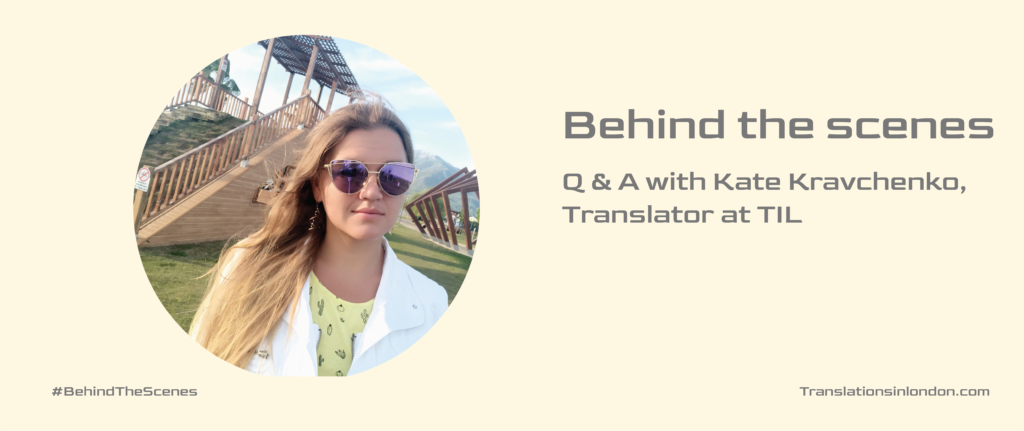Have you ever wondered about the life of a professional translator?
Like; what tools do professional translators use? or how they actually carry out their jobs.
To help shed more light on this, we interviewed TranslationsInLondon’s translator Kate Kravchenko, where we discussed everything from what happens behind the scenes of every successful translation project to the tools that help make every translation come together.

Q: Before we delve into the tools you use to carry out translation jobs, can you paint a picture of what your typical workflow looks like?
Kate: I am engaged in translation, but let me point out that linguistic education certainly helps me in my work. It gives a better understanding of the language and its development, which is very useful for the translator.
For written translation, my workflow is usually like this:
A translation agency or a client sends a request for a translation, I first estimate the scope, subject matter, and deadline. If it fits into my schedule and suits my experience, I accept the order and start to work.
Q: How has the pandemic affected your workflow?
Kate: I did not have to change my workflow and basically my usual lifestyle.
I worked as a freelancer even before the pandemic, so there is that aspect. The psychological factors certainly exists, but this is a new reality, and we have to live in it.
Q: Walk us through some of the tools you use for translation projects?
Kate: While the tools I use for work may differ depending on the nature of the project, I would summarize them into these groups.
CAT-tools: SDL Trados Studio, WordFast.
Other tools and sources: ABBYY FineReader, Multitran, Linguee, Microsoft Language Portal, and Reverso
Q: What CAT tool do you use for your translation project?
Kate: As I mentioned in your previous question, I most often use SDL Trados Studio and WordFast as my preferred Computer-aided translation tool.
Q: What, in your opinion, would you say is the most important feature in a CAT tool?
Kate: Off the top of my head, I would say simplicity, convenience, and ease-of-use.
The main task of a CAT tool should be to reduce the time spent on translating a document through machine translation. The substitution of ready-made translation parts from translation memory, automatic translation according to glossaries, quality control, etc. make the work a lot easier.
Let me also chip in that the biggest advantage of CAT systems is probably its Translation Memory.
“A CAT program provides translators with tools for automation, while leaving them the right to freely make decisions and proofread the translation.”
Q: Have you ever been able to work without these tools? (If the answer is yes, and there’s a story behind it, please share)
Kate: There is no peculiar story that stands out per-se,I would say that I come across texts in very different formats. Sometimes it could be handwritten text, bad photocopies of the documents, illegible or other kinds of unreadable source files. In these instances, I perform my translation without CAT-tools.
Q: What are your thoughts on MT, and what does it mean for translators?
Kate: Machine translation saves translators a significant amount of time when working. Also, improvements in machine translation could imply that maybe in the future, specialists will have to work exclusively on editing machine text.
But, in all fairness, it should be noted that in the foreseeable future, machine technology will not be totally able to replace a qualified human translator. In terms of translation quality, MT programs cannot compete with humans.
However, with the help of machine translation, you can significantly increase the efficiency of the translator’s work and make life easier for people who do not know the language.
Q:Finally, what do you recommend for someone just starting out as a translator?
Kate: Well, I have got a couple of recommendations, so I would just go ahead and list them.
- First off, decide for yourself which fields and topics interests you the most.
- Be enduring: for urgent tasks in translation
- Be reliable: translation is usually part of a larger process in which other processes depend upon, sometimes you have to work long nights and miss out on the social stuff
- Be able to adapt — I ability to mobilize resources at the right time and cope with challenges
- Be impartial: it is very important for translators to be able to convey in another language the emotion that was expressed in the original, and not their own;
- Be curious: if a person is not interested in studying various topics, he is unlikely to enjoy translating them
- Also, you probably should have a sense of humour.
In the work of a translator, the most difficult thing is to be diligent. This is a job that requires you to constantly sit in front of a PC and possibly put on glasses over time.
“The most interesting thing about translations is, of course, the opportunity to constantly learn something new.”
Do you have translation projects that requires industry standard tools and personnel?
Whether it is in the field of medicine or to translate legal documents, the professionals at Translationsinlondon are just an email away from making these projects a reality.